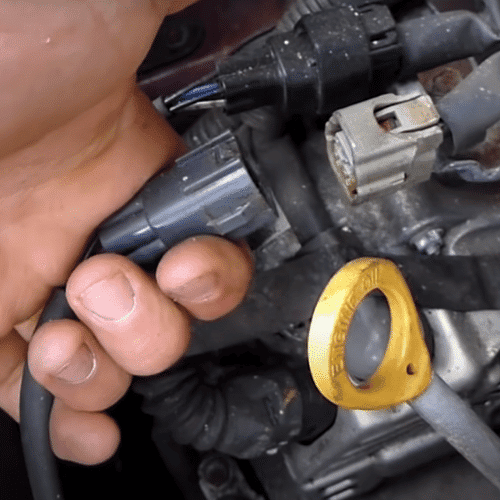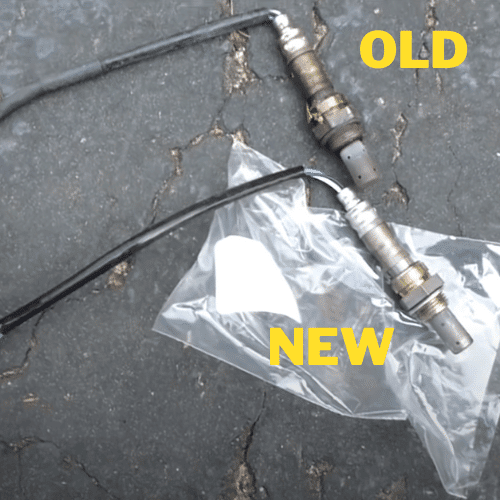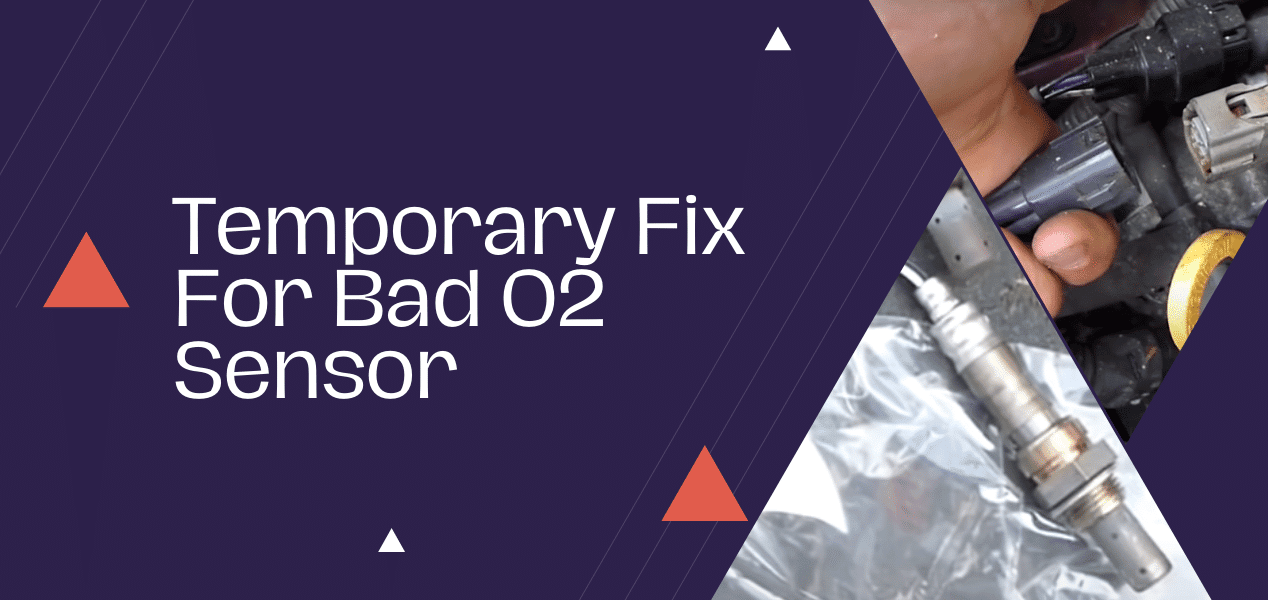The oxygen sensor of your car is a pretty crucial component. It lets the internal computer know whether the fuel mix is lean (too much oxygen) or rich (not enough oxygen). This information regarding the ratio is essential for the engine to make any necessary changes required to make the vehicle run optimally.
However, over time, the oxygen sensor can malfunction. And when that happens, the check engine light will come on, which can certainly be annoying. But is it possible to get the sensor working again without replacing it? Well, there is a temporary fix for bad O2 sensor!
How to Fix The O2 Sensor Temporarily
Before anything else, you should know that temporarily fixing a bad O2 sensor is not always a good idea. Oxygen sensor repair does not usually make the car run properly. In most cases, it will let you bypass the check engine light.
So, instead of temporarily fixing a bad O2 sensor, you should opt for oxygen sensor replacement. However, if your main aim is to disable the check engine light and plan to get a new sensor later, follow these steps:
Step 1: Prepare The Car
Regardless of whether you are aiming to fix the oxygen sensors or want to do other things with your car, let it cool down first. It could take a few hours for the exhaust system to cool down completely after driving the vehicle for a good while.
You should disconnect the negative battery wire from the terminal when the car cools down. All you need to do for this is loosen the nut and slide the clamp away. That will stop the electricity flow to the sensor electrical plug.
Step 2: Lift The Vehicle
When you are done with step 1, get the car lifted. For this, you would want to use jacks. Properly place them under the car’s jacking points and get the car lifted.
Step 3: Disconnect The Oxygen Sensor

You should look for the oxygen sensor now that the car is high. Generally, the oxygen sensors will be a part of the exhaust system. But sometimes, it can be inside the catalytic converter. In fact, for some cars, it could be before or after the catalytic converter. For such cases, there will be more than one oxygen sensor.
Nonetheless, when you get the location of the oxygen sensor, you should carefully unplug the wiring. This wiring will not be that long, so you should be extra careful when unplugging the oxygen sensor. Also, there will be a tab on the wiring, which you need to squeeze. Otherwise, the O2 sensor will not release from the housing.
Afterward, you will need to grab the o2 sensor and turn it counterclockwise until it comes loose.
Step 4: Insert A Dummy O2 Sensor
At this point, the bad O2 sensor should be out of the equation. And to temporarily fix the problems that the bad O2 sensor was causing, you should put a dummy sensor in place. The installation process for the dummy sensor is pretty much the reverse of what you just did.
That is, you will need to put the dummy sensor in place, rotate it clockwise, and make sure that the tab is clicked in place. Then, connect the sensor wiring and ensure that the wiring properly connects to the plug.
Step 5: Lower The Vehicle And Turn It On
After replacing the bad O2 sensor with the dummy sensor, you should lower the car. Connect the negative battery cable to the terminal and start your car. The check engine light should be gone. However, as we have mentioned earlier, replacing the bad O2 sensor with a dummy one is not a proper solution.
So, even if the check engine light is not there and some of the issues of the bad O2 sensor are not present, you should get a proper oxygen sensor replacement.
What Will Happen When The O2 Sensor Is Malfunctioning?
So, the need to fix the O2 sensor or get it replaced will be imminent when you see these happen with your vehicle:
High Fuel Consumption
The vehicle’s fuel economy will take a massive hit if the O2 sensor is not working correctly. It will happen even with all the other components of the vehicle working correctly. In fact, it can drop by 40 percent. And that would eventually mean you will need to spend more money to travel in your car.
Fuel Efficiency Will Suffer
Although many think that fuel efficiency and economy are the same, they are not. Fuel economy refers to the miles your car can drive with a gallon of fuel, while fuel efficiency describes how efficiently your car utilizes the fuel.
Nonetheless, the fuel efficiency will decrease significantly when the O2 sensor is not working correctly. Again, this will mean you must put more fuel into the vehicle to ride it.
Decrease in Engine Power
Poor engine performance is another sign of a failing oxygen sensor. And when the engine performance goes below the optimal range, you will face many issues. For example, there will be a flashing check engine light. Also, when the car engine sees a reduction in performance, a strong fuel smell will come from the exhaust pipe.
Furthermore, the exhaust emission will significantly increase. And eventually, the engine noises will increase. Basically, the engine is struggling when you are getting weak engine performance. You can also encounter an overheating engine when the oxygen sensor is not working properly.
Rough Idling
When the oxygen sensors do not work optimally, you will face the rough idling issue. Basically, when the vehicle has rough idle issues, the car engine will grind loudly when you step on the gas. Now, if this continues, there can be severe engine damage. And that is something that you would not want to deal with.
Failed Emission Tests
Routine maintenance will usually include the checking of exhaust gases. It states that the exhaust is not letting harmful gases in the environment. Well, when the oxygen sensors are not working, the vehicle’s exhaust system will not pass the emission tests.
Black Exhaust Fumes
A broken oxygen sensor will make the vehicle release black fumes from the exhaust manifold. But what does the bad oxygen sensor has to do with the exhaust manifold letting out black fumes? The O2 sensor will force the engine to operate with rich fuel.
In other words, the bad oxygen sensor will indicate that the gasoline level is too high in the fuel-air mixture. And when the fuel-air mixture is not handled correctly, the car will start to emit black gases.
Besides, the bad oxygen sensor might not be collecting enough oxygen for the issue within the intake manifold. That might also make the car emit black fumes through the exhaust.
Rotten Egg Smell from The Exhaust
A bad O2 sensor can cause the vehicle to exhaust a foul smell. The odor will be pretty similar to the rotten egg smell. And when this happens, it means that the engine is burning too much fuel. However, only a small amount of that fuel will turn into power.
Usually, this sign will be more visible when the vehicle suffers from poor fuel economy. But what happens to the other amount of fuel that the engine is not utilizing? Well, it turns into hazardous gases. At its core, this emission will contain too much sulfur dioxide. For that reason, the smell is like a putrid egg.
Although, this problem of the car is not only related to a bad O2 sensor. Most vehicles can emit this odor even when the o2 sensor is running properly. However, if the smell comes when there is a poor fuel economy issue, it generally means the oxygen sensor is faulty. Also, the car will not pass the emissions test at this stage.
Sudden Catalytic Converter Failure
The catalytic converter can collapse when the O2 sensor is not working correctly. Basically, the catalytic converters depend on the oxygen sensors for their operation. The O2 sensor will measure the air-fuel mixture and provide the results to the emissions control system.
However, when the information is incorrect, the catalytic converter will not work as it should. That can eventually make the catalytic converter heat up excessively and force it to stall.
What Conditions Make An O2 Sensor Fail?

There are plenty of reasons why the O2 sensor can fail on your car. However, among all of them, these are the most common reasons:
Internal Contamination
When oil or coolant leaks on the sensor, it will mess up the circuitry of the oxygen sensor. Also, you need to understand that the O2 sensor usually works within a narrow range of pressure and temperature. The leaking coolant or oil might make the O2 sensor exceed that range.
Now, why does the coolant or oil leak? Generally, it is for a cracked cylinder head or bad head gasket.
Excessive Oil Consumption
When the engine utilizes excessive oil, it can convert the functional O2 sensor into a faulty oxygen sensor. Basically, the higher amount of oil in the combustion chamber will coat the platinum tip inside the sensor. And when the tip of the O2 sensor has a coating, the sensor will render useless.
Wear And Tear
The O2 sensor can fail for normal wear and tear. That is why replacing the O2 sensor every 60 thousand miles to 90 thousand miles is recommended. Also, you should do routine maintenance on the O2 sensor. Through that, you can replace the O2 sensor before it turns into a faulty oxygen sensor.
Final Words
So, a temporary fix for bad o2 sensor is surely possible. All you need to do is get the bad oxygen sensor out of place and replace it with a dummy sensor. However, if you are facing issues related to a malfunctioning O2 sensor on your car, you should replace the bad O2 sensor with a functioning one.

